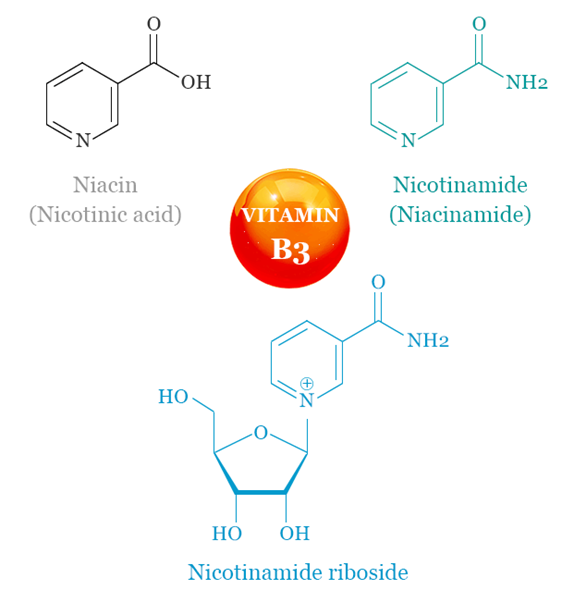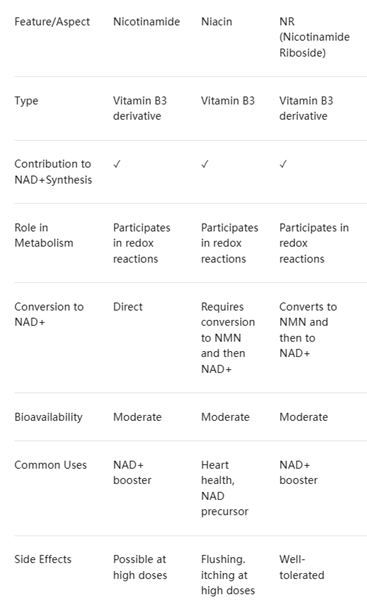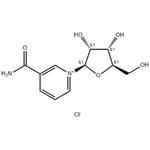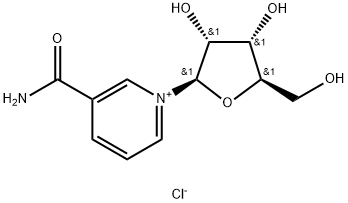Niacin vs Niacinamide vs Nicotinamide Riboside: what's the difference?
Mar 21,2024
Nicotinic acid, nicotinamide and nicotinamide riboside are the vitamin B3 precursors of nicotinamide adenine dinucleotide (NAD) in the human diet. NAD is an essential pyridine compound required for cellular bioenergetics and metabolism, as well as a key regulator of cellular processes such as epigenetic modification, DNA damage, repair and aging. Niacin is generally often referred to as vitamin B3, and nicotinamide and nicotinamide riboside are generally referred to as vitamin B3 derivatives.

What is Nicotinamide Riboside?
Nicotinamide riboside, abbreviated as NR, is a variant of vitamin B3 that is found in some foods in very small amounts. It is converted to NAD+ in the body to fuel our cells, replenish declining NAD+ levels and restore their vital role. It also has anti-ageing properties by supporting DNA repair mechanisms and promoting cell regeneration, revealing a role in slowing down the ageing process.
What is Niacinamide?
Niacinamide is the amide form of niacin, a water-soluble compound that is more similar to NAD and has fewer side effects. Niacinamide is essential for DNA repair, energy metabolism and cellular communication and is commonly found in multivitamin and B-complex supplements. Niacinamide has anti-inflammatory properties and is used to treat pellagra and acne. However, studies have shown that gastrointestinal symptoms occur when taking niacinamide, and high doses may increase the risk of type II diabetes.
What is Niacin?
Niacin, also referred to as nicotinic acid, is another form of vitamin B3. Like nicotinamide, niacin is vital for converting food into energy and supporting various cellular processes. However, niacin differs from nicotinamide in that it can cause a temporary "niacin flush." This flush is characterized by a warm, tingling sensation and reddening of the skin, which occurs due to the widening of blood vessels.
Additionally, niacin is a medication for high cholesterol, and niacin also promotes phosphate control in the kidneys, which helps with kidney function. However, the side effects are also more pronounced, with intense flushing, which can be uncomfortable and lead to redness, itching and warmth of the skin.
The differences between the three are shown below:

- Related articles
- Related Qustion
- What are the benefits of Nicotinamide riboside chloride supplement? What is the appropriate daily dosage? May 15, 2025
Nicotinamide riboside chloride (NRCl) is an FDA-approved nutritional supplement that can be used to increase NAD+ levels.
- Nicotinamide riboside chloride: biological activities and preclinical studies Jan 24, 2024
Nicotinamide riboside chloride increases NAD+ levels, has similar toxicity to nicotinamide, and shows potential benefits in metabolism, liver health, and exercise performance.
- Stability of Nicotinamide riboside chloride and chemical properties of its derivatives Nov 16, 2023
Nicotinamide riboside chloride (NRCl) is a potent form of vitamin B3. However, it cannot be used in ready-to-drink (RTD) beverages or high-water active foods due to its instability in water.
Supplementation with pyridoxal 5'-phosphate monohydrate can synthesize neurotransmitters such as dopamine and serotonin, maintaining a healthy nervous system.....
Nov 4,2025Biochemical EngineeringFluticasone propionate belongs to a class of drugs called corticosteroids. It can help reduce inflammation. It is available as a cream or ointment, nasal spray, and inhaler.....
Mar 21,2024APINicotinamide riboside chloride
23111-00-4You may like
- Diosgenin:Uses,Functions and Synthesis
Dec 12, 2025
- Biosynthesis of Cyclopamine from Cholesterol
Dec 10, 2025
- Synthesis of ribociclib
Dec 10, 2025
Nicotinamide riboside chloride manufacturers
- Nicotinamide riboside chloride
-

- 2025-12-15
- CAS:23111-00-4
- Min. Order:
- Purity: 0.99
- Supply Ability:
- Nicotinamide riboside chloride
-

- $0.00 / 1KG
- 2025-12-15
- CAS:23111-00-4
- Min. Order: 1KG
- Purity: 97%min
- Supply Ability: 100KG
- Nicotinamide riboside chloride
-

- $130.00/ kg
- 2025-12-15
- CAS:23111-00-4
- Min. Order: 1kg
- Purity: 98%
- Supply Ability: 1 tons






